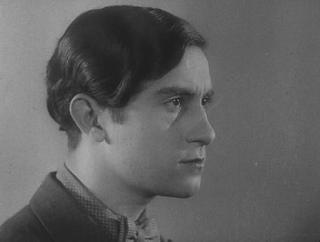Watching this minor surrealist masterwork I was reminded of my English teacher’s response to an attempt I’d made at composing a dada-esque poem (i.e. one without any poetry…), “is this deep - how can I mark it?” I’d been rumbled, but how to judge any work of attempted surrealism – there’s a fine line between the charlatan and the champion (although it was fairly broad in the case of my teenage verse…).
Directed by Henri d' Ursel, The Pearl (1929) owes an obvious debt to Buñuel, Dali and Man Ray… not to mention Louise Feuillade, it’s stylishly done and may well mean something.
Written and starring Georges Hugnet as Le Jeune Homme, The Pearl could signify possession or it could mean love… it may even be just a pearl. I don’t think it matters to any forensic degree, you can overlay your own interpretation according to mood: the key thing is that the film draws you in and makes you think. This properly defies any constraining interpretations and, by the rules, your guess is as good as mine.
All we know for certain is what happens on screen. A pearl is made and extracted from the sea. A young Lulu (Mary Stutz) waits in her garden for her fiancé and he sets off to buy her a pearl necklace.
  |
| Waiting for her man... |
But he has it in mind to buy his girl a pearl necklace.
 |
| Georges Hugnet |
 |
| Kissa Kouprine |
 |
| Georges Hugnet and Kissa Kouprine |
La Voleuse shares a bath with one of her doppelgangers and the two play dice. Is this a celebration of chance or an actual game to decide a winner?
The man and La Voleuse share a room and clearly more as they wake the next day. Decisions need to be made. Who gets the pearls now?
  |
| He's just a boy who can't say no... |
The man returns to Lulu with a letter explaining his purchase and his sorrow…the somnambulist casually deposits the pearls around Lulu’s neck and she is united with her fiancé… but too much distance is now between them. The young man walks off and spots La Voleuse…giving chase…
 |
| Renée Savoy |
This is how The Pearl ultimately works well containing enough reality and enough dream to hold together as a narrative: vaguely familiar…
Georges Hugnet looks suitably perturbed throughout whilst Mary Stutz is patiently engaged. Most of the genuine expression comes from the beguiling Kissa Kouprine who offers the only emotionally connected character. She was the only professional actor on show and featured in a number of Marcel L’Herbier’s films.
 |
| Kissa Kouprine |
I watched the Surrealism and Experiment in Belgian Cinema DVD available from Cinematek.



.png)
+pearls.png)

+colour.png)





+hill+trip.jpg)



Here is a film that me thinks must see
ReplyDeleteSurreal and Dada float on film to view
As a poem my master wrote before me
Pearl, Gawain poet, his mind it grew!
You're not wrong Good Knight! Sir Real and his father broke the surface tension and delivered the Pearl to the Poet thereafter.
ReplyDeleteOr, as Sir Stanley Unwin said: "Far better to get a pot of paintings, severaload bottles of inkit, scrurp it huffalo-dowder the wall and stand hupside-dowdle and play a skating march. Because in this it would express the idea in the viewer, because everything is in the heart or the eye of the beholder."
Arthur